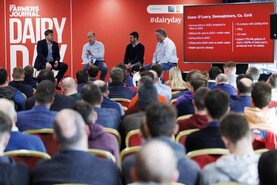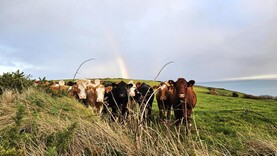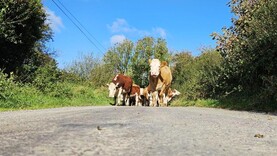Preparations will get under way for calving shortly. The calving shed doubles as the main straw and hay store from June to January, so working out where to swap around bales to make space there is high on the agenda for this week.
Having sheds that can fulfil a few roles means you get bang for your buck from them, but there’s always once or twice in a year where you need to rejig them.
In order to save time, there’s a bit of planning needed for that. In a way, it’s a real-life version of the puzzle where you need to get a fox, hen and sack of grain across the river, but can only take two at a time.
It’s not a big deal, but a bit of thinking now can save a lot of time when things get busy.
Priority
The main calving pen consists of two bays that are straw-bedded, with a feeding area alongside it. As half of it is storing bales now, freeing that up is a priority.
In order to do that, I’ll need to clean out the straw-bedded area of the cow house. In recent years, the rest of the main cow shed has been used to hold older cows ahead of calving – a move to use easier calving bulls facilitated this move.
A bay of that is then used to store straw, so that it is conveniently next to where it’s required. It took a while to end up with this system, but it frees up a lot of time and knocked a lot of rushing around out of what is a busy time on farm.
The heifers are the main group that go to the straw shed. It’s mainly the heifers closest to calving, but they’re often joined by any heifer that is a bit flighty. Thankfully, those are thinner on the ground this year.
For whatever reason, that house seems to have a settling effect on them. Maybe because there is more interaction with me in terms of bedding or feeding; or maybe they just like the sound of the radio that’s there.
There’s an old milking byre in there, which we divided into five separate pens, and this is used for heifers if they’re a bit slower taking to their calves.
The old milking stalls still function and act as both a barrier and for stalling a cow if there’s ever any need to intervene. They also have a gym function, as they must be cleaned out by hand.
Ideally, they’re cleaned out after every pair that’s in them, but this can vary depending on how busy things are.
Calving camera
Those pens are where cows used to be brought for calving 20 years ago, but installing a calving camera meant we changed how we approached calving too.
Being able to observe how they progressed with calving from afar was a game-changer. Before, a small thing like when you opened the door of the shed would have seen them lose focus on calving. Standing there and looking at them had the same effect.
Having the cameras allowed observation from a distance and created a more relaxed calving season.
Intervention is only used when necessary now, and cow behaviour was a good signal that calving was imminent. They’d start circling around the group and either corner of the inside corners proved to be their favourite spot to calve.
I’d better move the bales from there for them so.






 This is a subscriber-only article
This is a subscriber-only article










SHARING OPTIONS: